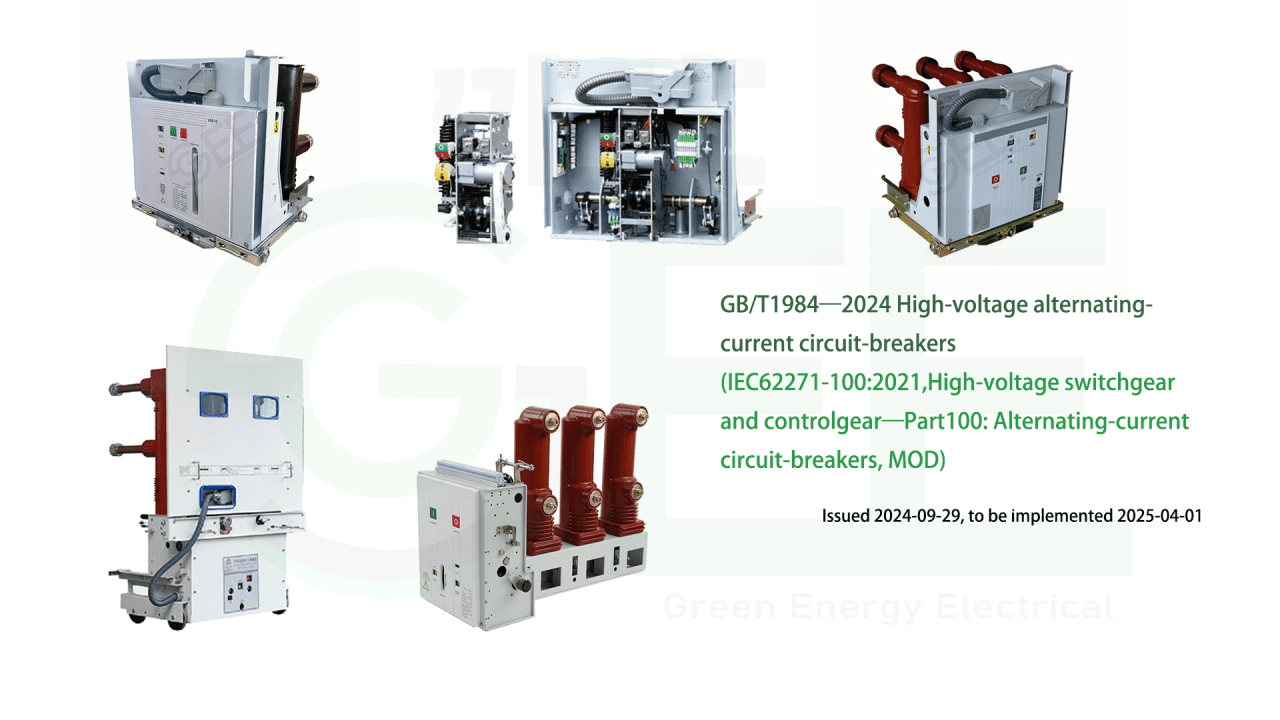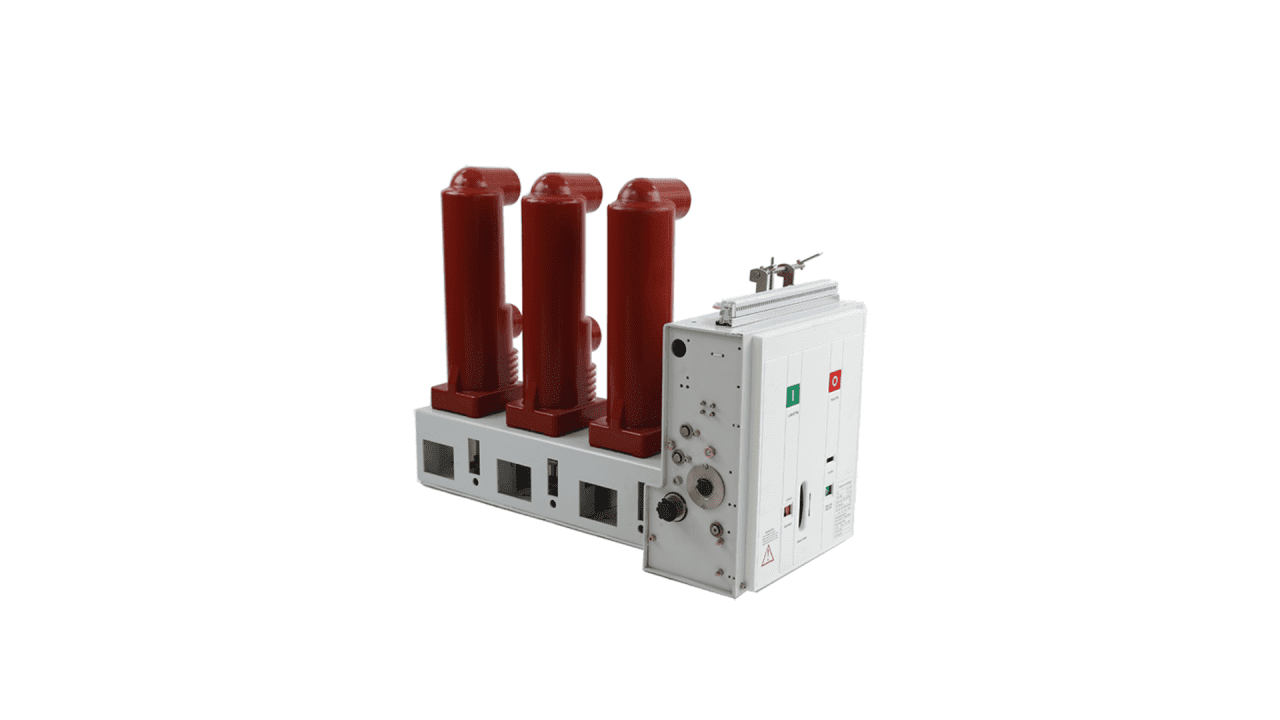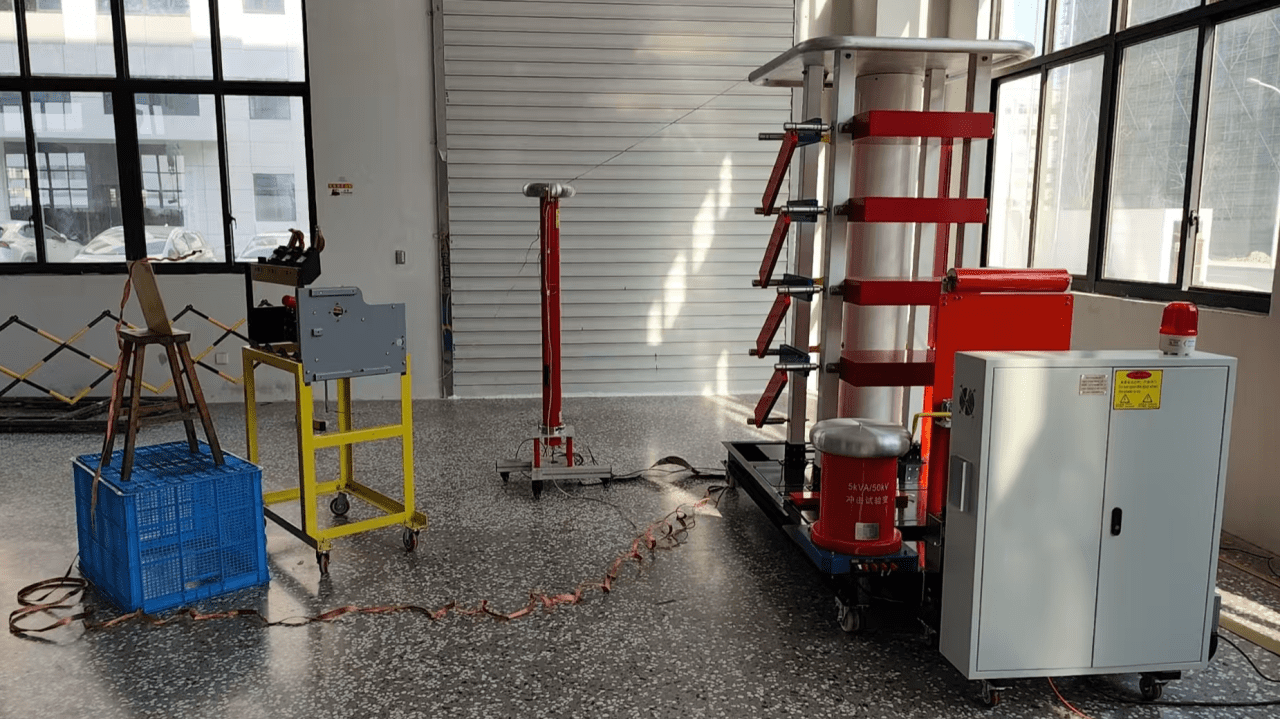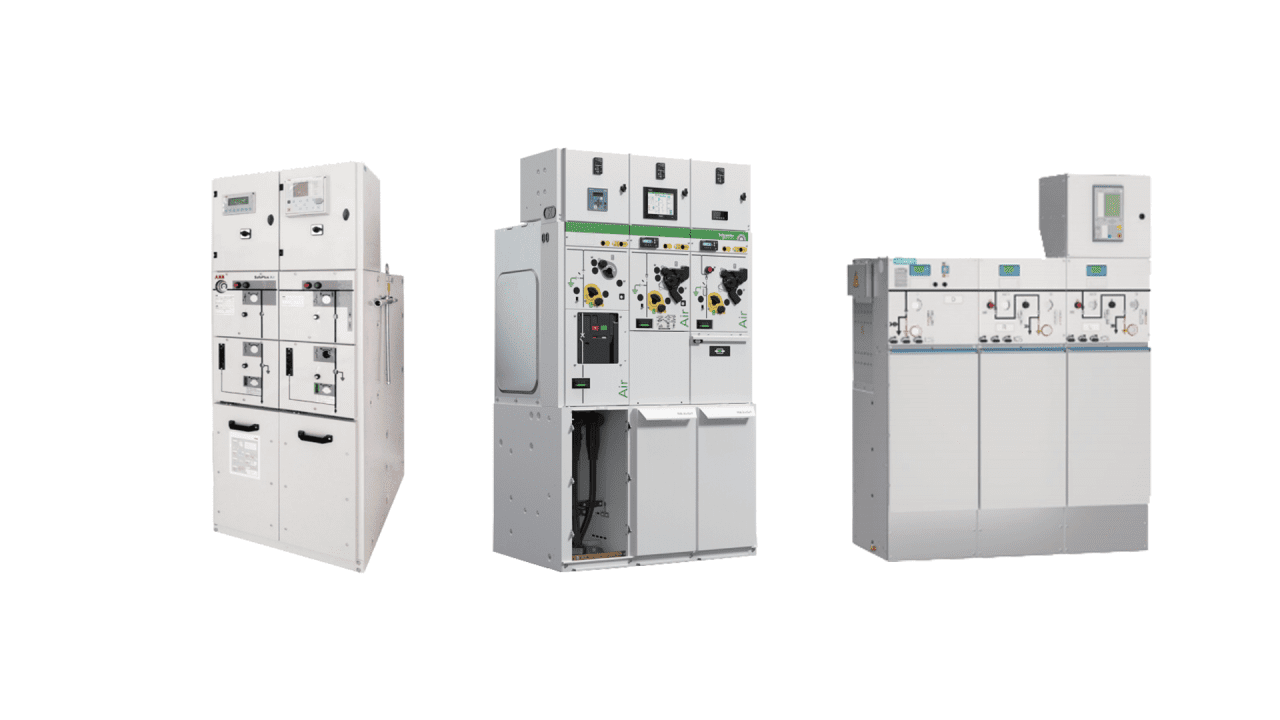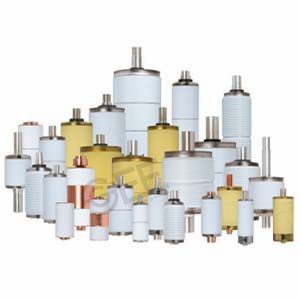The latest version of GB/T1984—2024 High-voltage alternating-current circuit-breakers (IEC62271-100:2021, High-voltage switchgear and controlgear—Part 100: Alternating-current circuit-breakers, MOD) was released on 2024-09-29 and will be implemented on 2025-04-01. The main revisions are as follows:
- Deleted terms and definitions such as “indoor switchgear and controlgear, outdoor switchgear and controlgear, earth fault factor, self-restoring insulation, non-self-restoring insulation, cable system, line system” (see Chapter 3 of the 2014 edition);
- Changed the positions of “transient recovery voltage related to rated short-circuit breaking current”, “characteristics of short-line fault”, “rated time parameters”, “number of mechanical operations”, and “classification according to electrical life” in the text (see 7.105, 7.109, 6.105, 7.101, 6.107 in the 2014 edition, 4.102, 4.105, 4.109, 4.110, 4.111);
- Deleted “rated single capacitor bank closing inrush current, inductive load switching”, and “CO—t—CO” in the rated operating sequence (see 4.107.5, 4.108, 4.104 in the 2014 edition);
- Added “rated first pole to clear factor” (see 5.1);
- Deleted the requirements of items 2, 3, 4, 7, and 10 in the auxiliary equipment (see 5.4 in the 2014 edition);
- Added the requirements of “manual operation actuator”, “time parameters”, “mechanical load”, and “classification of circuit breakers” (see 6.8, 6.105, 6.106, and 6.107);
- Deleted the requirements for the number of product samples and test grouping in type tests (see 6.1.1 in the 2014 edition).
The 2014 edition stipulates as follows:
“6.102.2 Quantity of test samples
GB/T11022-2011 6.1.2 applies, with the following supplement:
As a recommended experience for conducting short-circuit closing, opening, and switching tests (including terminal fault, short-line fault, out-of-step, and capacitive current switching tests when applicable), these tests should be carried out on one test sample. During short-circuit tests, and between each independent test series for other non-short-circuit tests, maintenance can be carried out if necessary and allowed. The manufacturer shall inform the test laboratory of the parts that need to be replaced during the test.
However, it should be noted that in the case where several test methods should be carried out at the same location in the same test station, the above limitations may become uneconomical constraints. In this case, a maximum of two test samples are allowed for the above tests. At this time, the two test samples should be fully verified in accordance with GB/T11022-2011 6.1.2; in addition, the mechanical stroke characteristics of the two test samples should be within the tolerance range given in 6.101.1.1.
As a supplement, for circuit breakers with independent mechanisms for each pole, single-phase pole tests should be carried out. As a supplement to the two test samples, up to two pole-breaking units can also be used.
If a unit or multiple units of one pole are tested as a unit test, the total number of units used in a single test can be considered as one test sample, taking into account the provisions of 6.102.4.2.3. In this case, two test samples and the corresponding operating mechanisms and up to two additional test samples (appropriate breaking units) can be used.
The graphic illustration of the allowable number of test samples for closing, opening, and switching tests is shown in Figure 21. The graphic illustration of the definition of test samples in accordance with GB/T10222-2011 3.2.1 is shown in Figure 22.”
This paragraph is excerpted from “GB/T1984—2024 High-voltage alternating-current circuit-breakers”.
- Added “insulation test” [see 7.1.1c)]; Unlike the power frequency withstand voltage frequency range of 45~65Hz in GB/T11022—2011 (the upper limit was also changed to 55Hz in GB/T11022-2020), the power frequency withstand voltage frequency range required in GB/T1984-2024 is 45~55Hz. If the circuit breaker product is to meet the application of 60Hz, the power frequency withstand voltage test report will not be applicable. This is not conducive to internationalization.
- Deleted “terminal static load test” (see Table 11 and 6.101.6 in the 2014 edition), and “switching test of shunt reactors and motors” (see Table 11 in the 2014 edition);
- Added “X-ray test” and “noise level test” (see Table 5);
- Added the requirements for “type tests repeated on circuit breakers with alternative operating mechanisms” (see 7.1.102);
- Added the requirements for partial discharge test of “GIS circuit breakers and circuit breakers with uncharged enclosures” (see 7.2.10);
- Changed the requirements for condition inspection after mechanical or environmental tests and after closing and opening tests (see 7.2.12.101, 7.2.12.102, Table 8, 6.2.11, 6.101.1.4, 6.102.9 in the 2014 edition);
- Deleted the “explanation of temperature rise test” (see 6.5.6 in the 2014 edition);
- Deleted the corresponding requirements for circuit breakers with direct overcurrent release and self-tripping circuit breakers (see 6.6.1 in the 2014 edition), and “performance of circuit breakers in tests” (see 6.6.3 in the 2014 edition);
- Added the requirement that “there is no mandatory requirement for the fluid used for insulation and/or switching. Air or nitrogen can be used to replace gases that may cause global warming. There is also no requirement for the minimum pressure of the fluid filled” (see 7.6.2);
- Added the operating temperature requirements for products that need to be tested at high and low temperatures (see 7.101.3.1);
- Added the “additional requirements for outdoor metal-enclosed circuit breakers” (see 7.101.3.2);
- Added that “the closing and opening tests carried out in accordance with S2 level cover the closing and opening tests of S1 level” (see 7.102.1);
- Added the combined requirements for verification tests when tests are required at both 50Hz and 60Hz (see 7.102.4.1); IEC62271-100:2017 When testing a circuit-breaker for 50 Hz and 60 Hz, verification tests shall only be performed at 50 Hz or 60 Hz, provided the following two conditions are met:— the arcing time for breaking shall be the longest expected arcing time in the last-pole-to clear at 50 Hz; – during the making operation with asymmetrical current the rated short-circuit making current for 60 Hz shall be achieved. When testing a circuit breaker that requires both 50Hz and 60Hz, as long as the following two conditions are met, the verification test only needs to be carried out at 50Hz or 60Hz once:——— The arcing time in the breaking test should be equal to the longest expected arcing time of the last pole to clear at 50Hz;——— The rated short-circuit closing current at 60Hz should be obtained during the asymmetrical current closing operation.
The 2016 edition of the STL guideline requires that tests of T60/T100 be carried out at both frequencies when 50&60Hz are required. It is unknown whether the new STL guideline has been changed.
- Added that “within 1/4 power frequency cycle after breaking, the reappearance of the power frequency current of any pole shall be broken by the circuit breaker. After the first short-circuit breaking of all poles, the reappearance of the power frequency current after more than 1/4 power frequency cycle is a breaking failure.” (see 7.102.8);
- Changed the requirements for “the state of the circuit breaker after the test” (see 7.102.9, 6.102.9 in the 2014 edition);
- Added the inspection method and requirements for the continuous current carrying capacity of the lifetime sealed circuit breaker (see 7.102.9.4);
- Changed the time when the power frequency recovery voltage can be reduced to Ur/3 [see 7.103.4b), 6.104.7b) in the 2014 edition];
- Changed the regulations on the arcing time (see 7.104, 6.102.10 in the 2014 edition);
- Changed the range of the “minimum breaking time” interval and other related parameters and test procedures related to T100a (see 7.104.2.2, 6.102.10.1.2 in the 2014 edition);
- Changed the effective criterion of test method T100a, changing the “product of I×Δt is between 81% and 121% of the required value” to “product of I×Δt is between 90% and 110% of the required value” (see 7.104.2.2, 7.104.3.3, 6.102.10 in the 2014 edition);
- Added and changed Table 11 to replace Tables 15~19 (see Table 11, Tables 15~19 in the 2014 edition);
- Added the “test covering the conditions of kpp = 1.3 and kpp = 1.5” in the three-phase test (see 7.104.2.3);
- Changed the amplitude coefficients of T10 and T30 in the expected TRV of S1 level circuit breakers (see Table 16, Table 21 in the 2014 edition);
- Added the expected TRV of S2 level circuit breakers with rated voltages of 3.6kV, 7.2kV, and 12kV (see Table 17, Table 22 in the 2014 edition);
- Changed the amplitude coefficients of T100 and T10 for rated voltages greater than 800kV; for test method T100, t2 was changed from “t2 = 4t1” to “t2 = 3t1”; for test method T60, t2 was changed from “t2 = 6t1” to “t2 = 4.5t1”; the TRV of OP1 and OP2 was changed from the four-parameter method to the two-parameter method [see 7.105.5.1c), Table 23 in the 2014 edition];
- Changed the arcing time and other contents during the breaking operation (see 7.108.2.3, 6.108.3 in the 2014 edition);
- Changed the wave impedance and RRRV coefficient of the short-line fault test for rated voltages greater than 800kV (see Table 25, Table 8 in the 2014 edition);
- Changed some parameters of the rated voltages of 24kV, 40.5kV, 72.5kV, and 1100kV in the standard value of the expected TRV of the power supply side circuit in Table 26 (see Table 26, Tables 2~5 in the 2014 edition).

(IEC62271-100:2021 standard TRV, the new GB standard has changed the embarrassment that the 40.5kV T10 TRV of the old standard is lower than that of IEC 36kV.)

- Changed the requirements of C1 and C2 levels in the capacitive current test (see 7.111, 6.111 in the 2014 edition);
- Added that the capacitive voltage coefficient kc = 1.3 for circuit breakers with rated voltages greater than 800kV (see 7.111.7);
- Changed the step size of the capacitive current switching test (see 7.111.9, 6.111.9 in the 014 edition);
- Added the maximum number of tests for each test method in the capacitive current switching test (see 7.111.9);
- Deleted the test times requirement for the longest arcing time in C1 level and the preferred test sequence; deleted the preferred test sequence for line and cable switching tests in C2 level (see 6.111.9.1, 6.111.9.2 in the 2014 edition);
- Changed the position of “verification of capacitive current breaking in the presence of single-phase or two-phase earth faults” in the text (see Appendix J, 6.111.9.3 in the 2014 edition);
- Deleted the relevant description of the “sequence” of the electrical life test (see 6.112.2 in the 2014 edition);
- Added the percentage of injected energy in Sequence 4 (see Table 30); using these calculations and settings, the energy injected in Sequence 1 is 100%, the energy injected in Sequence 2 is 125%, and the energy injected in Sequence 3 is 134%. Therefore, Sequence 3 can be used instead of Sequence 1 and Sequence 2 to reduce the number of different test circuits.
- Added the calculation of the equivalent gas pressure when pure SF6 gas is used in the main circuit insulation test of circuit breakers using mixed gas (see 8.2);
- Added “partial discharge measurement” (see 8.2.101);
- Added the parameters of the rated short-circuit closing current at 60Hz (see 9.103.4); when the rated frequency is 50Hz and the direct current time constant τ = 45ms, its value is 2.5 times the alternating current component of the rated short-circuit breaking current of the circuit breaker (that is, approximately 1.82 times). When the rated frequency is 60Hz and the direct current time constant τ = 45ms, its value is 2.6 times the alternating current component of the rated short-circuit breaking current of the circuit breaker.
- Deleted the determination of short-circuit power factor (see Appendix D in the 2014 edition);
- Deleted the calculation of TRV parameters under asymmetrical fault conditions (T100a) (see Appendix P in the 2014 edition);
- Added the normative appendix “verification of capacitive current breaking in the presence of single-phase or two-phase earth faults” (see Appendix J).
This article is excerpted from “GB/T1984—2024 High-voltage alternating-current circuit-breakers” for reference only. The test parameter requirements of the newly revised GB/T1984 are basically the same as those of IEC62271-100:2021, which is very conducive to the acceptance of domestic GB standard tests of switchgear by IEC customers and is more conducive to the globalization of China circuit breakers!

